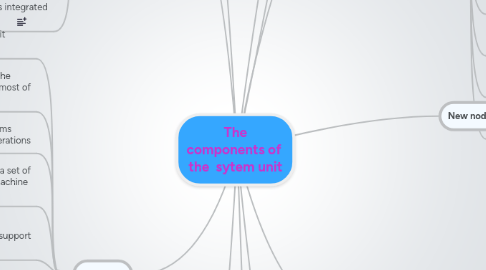The components of the sytem unit
por A Little'Monkey Notz


1. The System Unit
1.1. The system unit is a case that contains electronic components of the computer used to process data
1.2. The inside of the system unit on a desktop personal computer includes:
1.2.1. Drive bay(s)
1.2.2. Power supply
1.2.3. Sound card
1.2.4. Video card
1.2.5. Processor
1.2.6. Memory
1.3. The motherboard is the main circuit board of the system unit – A computer chip contains integrated circuits
2. Processor
2.1. The processor, also called the central processing unit (CPU), interprets and carries out the basic instructions that operate a computer – Contain a control unit and an arithmetic logic unit (ALU)
2.2. • The control unit is the component of the processor that directs and coordinates most of the operations in the computer
2.3. The arithmetic logic unit (ALU) performs arithmetic, comparison, and other operations
2.4. For every instruction, a processor repeats a set of four basic operations, which comprise a machine cycle
2.5. Most current personal computers support pipelining
2.5.1. Processor begins fetching a second instruction before it completes the machine cycle for the first instruction
2.6. The processor contains registers, that temporarily hold data and instructions
2.7. The system clock controls the timing of all computer operations
2.8. The pace of the system clock is called the clock speed, and is measured in gigahertz (GHz)
2.9. Determine how you plan to use a new computer before selecting a processor
2.10. A processor chip generates heat that could cause the chip to burn up
2.11. Require additional cooling – Heat sinks – Liquid cooling technology
2.12. Parallel processing uses multiple processors simultaneously to execute a single program or task – Massively parallel processing involves hundreds or thousands of processors
3. Expansion Slots and Adapter Cards
3.1. An expansion slot is a socket on the motherboard that can hold an adapter card
3.2. An adapter card enhances functions of a component of the system unit and/or provides connections to peripherals – Sound card and video card
3.3. With Plug and Play, the computer automatically can configure adapter cards and other peripherals as you install them
3.4. Removable flash memory includes: – Memory cards, USB flash drives, and PC Cards/ExpressCard modules
4. Ports and Connectors
4.1. A port is the point at which a peripheral attaches to or communicates with a system unit (sometimes referred to as a jack)
4.2. A connector joins a cable to a port
4.3. On a notebook computer, the ports are on the back, front, and/or sides
4.4. A port replicator is an external device that provides connections to peripherals through ports built into the device
4.5. A docking station is an external device that attaches to a mobile computer or device
5. Bays
5.1. A bay is an opening inside the system unit in which you can install additional equipment – A drive bay typically holds disk drives
5.2. The power supply converts the wall outlet AC power into DC power
5.3. Some external peripherals have an AC adapter, which is an external power supply
6. Putting It All Together
7. Objectives Overview
7.1. Differentiate among styles of system units on desktop computers, notebook computers, and mobile devices
7.2. Identify chips adapter cards, and other components of a motherboard
7.3. Describe the control unit and arithmetic logic unit components of a processor,and explain the four steps in a machine cycle
7.4. Identify characteristics of various personal computer processors on the market today and describe the ways processors are cooled
7.5. Define a bit and describe how a series of bits represents data
7.6. Explain how program instructions transfer in and out of memory
7.7. Differentiate among the various types of memory
7.8. Describe the purpose and types of expansion slots and adapter cards, and differentiate among slots for various removable flash memory devices
7.9. Differentiate between a port and a connector, and explain the differences among a USB port, FireWire port, Bluetooth port, SCSI port, eSATA port, IrDA port, serial port, and MIDI port
7.10. Describe the types of buses in a computer
7.11. Explain the purpose of a power supply and describe how it keeps cool
7.12. Understand how to clean a system unit on a computer or mobile device
8. Data Representation
8.1. Analog signals are continuous and vary in strength and quality
8.2. Digital signals are in one of two states: on or off
8.3. A computer circuit represents the 0 or the 1 electronically by the presence or absence of an electrical charge
8.4. Eight bits grouped together as a unit are called a byte. A byte represents a single character in the computer
8.5. ASCII (American Standard Code for Information Interchange) is the most widely used coding scheme to represent data
9. Memory
9.1. Memory consists of electronic components that store instructions waiting to be executed by the processor, data needed by those instructions, and the results of processing the data
9.2. Stores three basic categories of items:
9.3. Each location in memory has an address
9.4. Memory size is measured in kilobytes (KB or K), megabytes (MB), gigabytes (GB), or terabytes (TB)
9.5. The system unit contains two types of memory
9.5.1. Volatile memory
9.5.2. Nonvolatile memory
9.6. Three basic types of RAM chips exist:
9.6.1. Dynamic RAM
9.6.2. Static RAM (SRAM
9.6.3. Magnetoresistive RAM (MRAM)
